Case Study Report: Design Thinking and Innovation at the ATO
VerifiedAdded on 2023/03/31
|20
|3563
|112
Report
AI Summary
This report presents a case study analysis of the Australian Taxation Office (ATO), focusing on its application of design thinking to solve complex issues, particularly in its superannuation reform project. The analysis explores the ATO's use of design thinking methods, theories, and tools, highlighting the importance of user-centric approaches and the principles of collaboration, co-design, and consultation. The report delves into the five phases of the ATO's design process, including establishing intent, blueprinting, design facilitation, artefact creation, and implementation. Furthermore, the report discusses the role of creativity and innovation in organizational success, drawing parallels to companies like Apple, and examines the ATO's design-led innovation process, including the 'what is, what if, what wows, and what works' framework. The report also includes personal reflections on creativity and insights gained from the ATO case study, emphasizing the impact of design thinking approaches on project outcomes and organizational change.
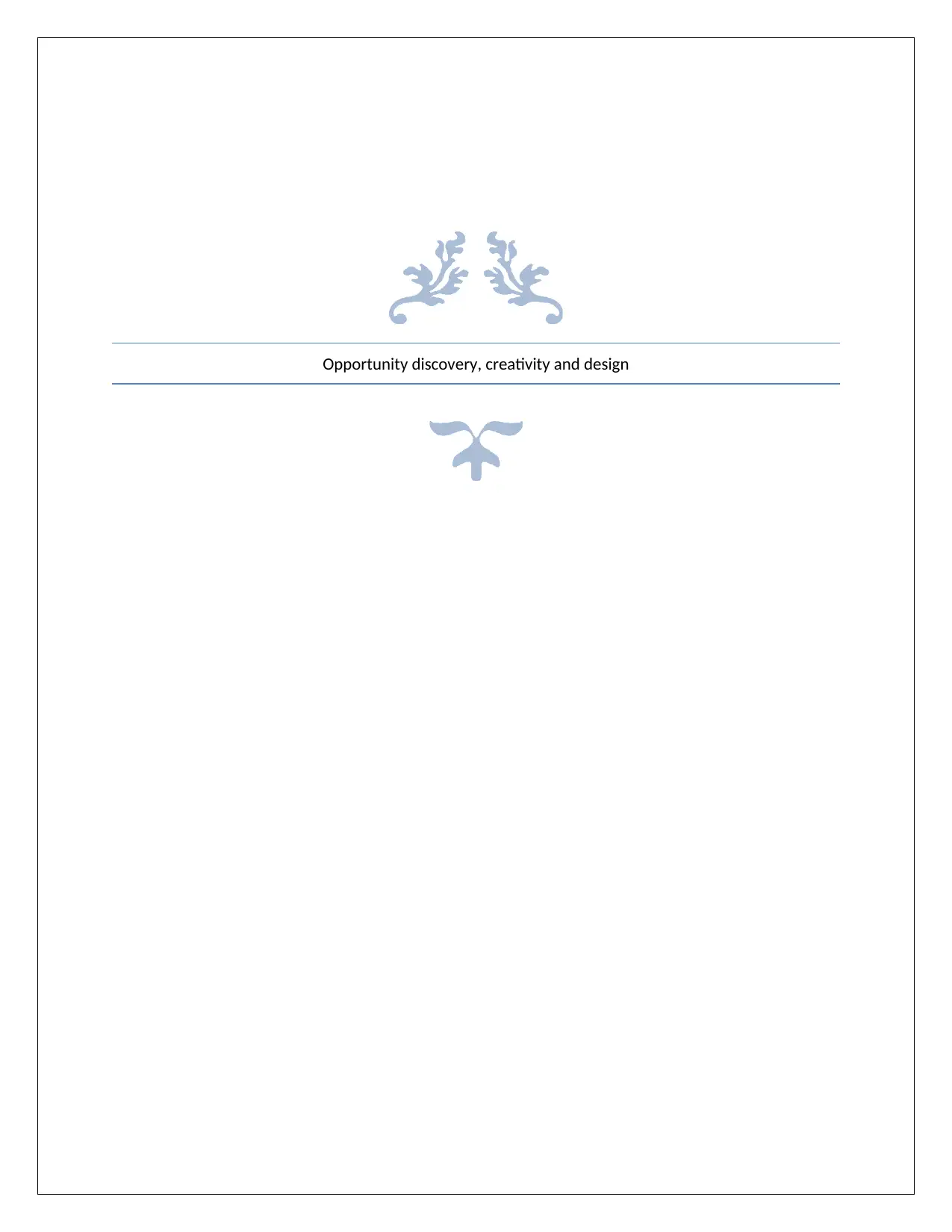
Opportunity discovery, creativity and design
Paraphrase This Document
Need a fresh take? Get an instant paraphrase of this document with our AI Paraphraser
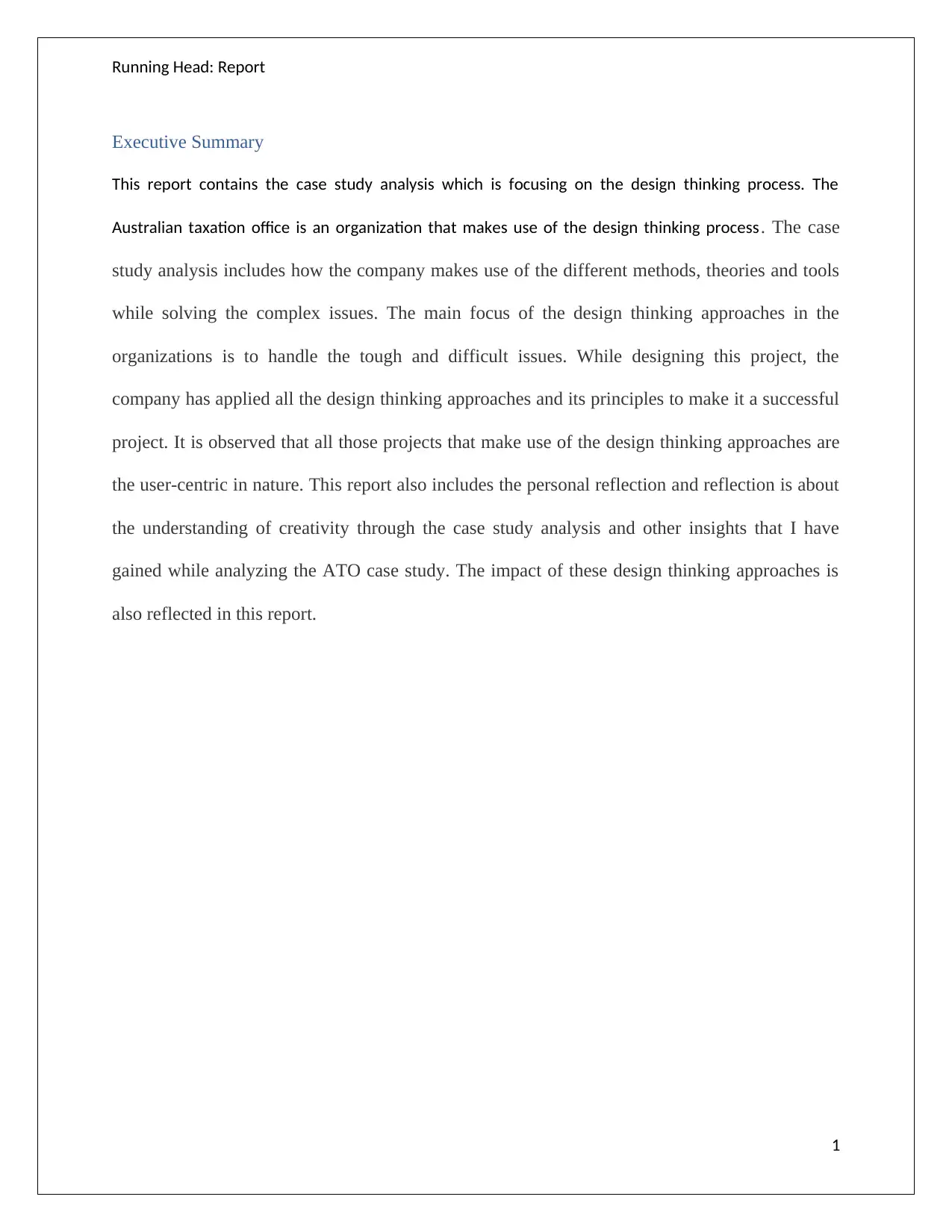
Running Head: Report
Executive Summary
This report contains the case study analysis which is focusing on the design thinking process. The
Australian taxation office is an organization that makes use of the design thinking process. The case
study analysis includes how the company makes use of the different methods, theories and tools
while solving the complex issues. The main focus of the design thinking approaches in the
organizations is to handle the tough and difficult issues. While designing this project, the
company has applied all the design thinking approaches and its principles to make it a successful
project. It is observed that all those projects that make use of the design thinking approaches are
the user-centric in nature. This report also includes the personal reflection and reflection is about
the understanding of creativity through the case study analysis and other insights that I have
gained while analyzing the ATO case study. The impact of these design thinking approaches is
also reflected in this report.
1
Executive Summary
This report contains the case study analysis which is focusing on the design thinking process. The
Australian taxation office is an organization that makes use of the design thinking process. The case
study analysis includes how the company makes use of the different methods, theories and tools
while solving the complex issues. The main focus of the design thinking approaches in the
organizations is to handle the tough and difficult issues. While designing this project, the
company has applied all the design thinking approaches and its principles to make it a successful
project. It is observed that all those projects that make use of the design thinking approaches are
the user-centric in nature. This report also includes the personal reflection and reflection is about
the understanding of creativity through the case study analysis and other insights that I have
gained while analyzing the ATO case study. The impact of these design thinking approaches is
also reflected in this report.
1
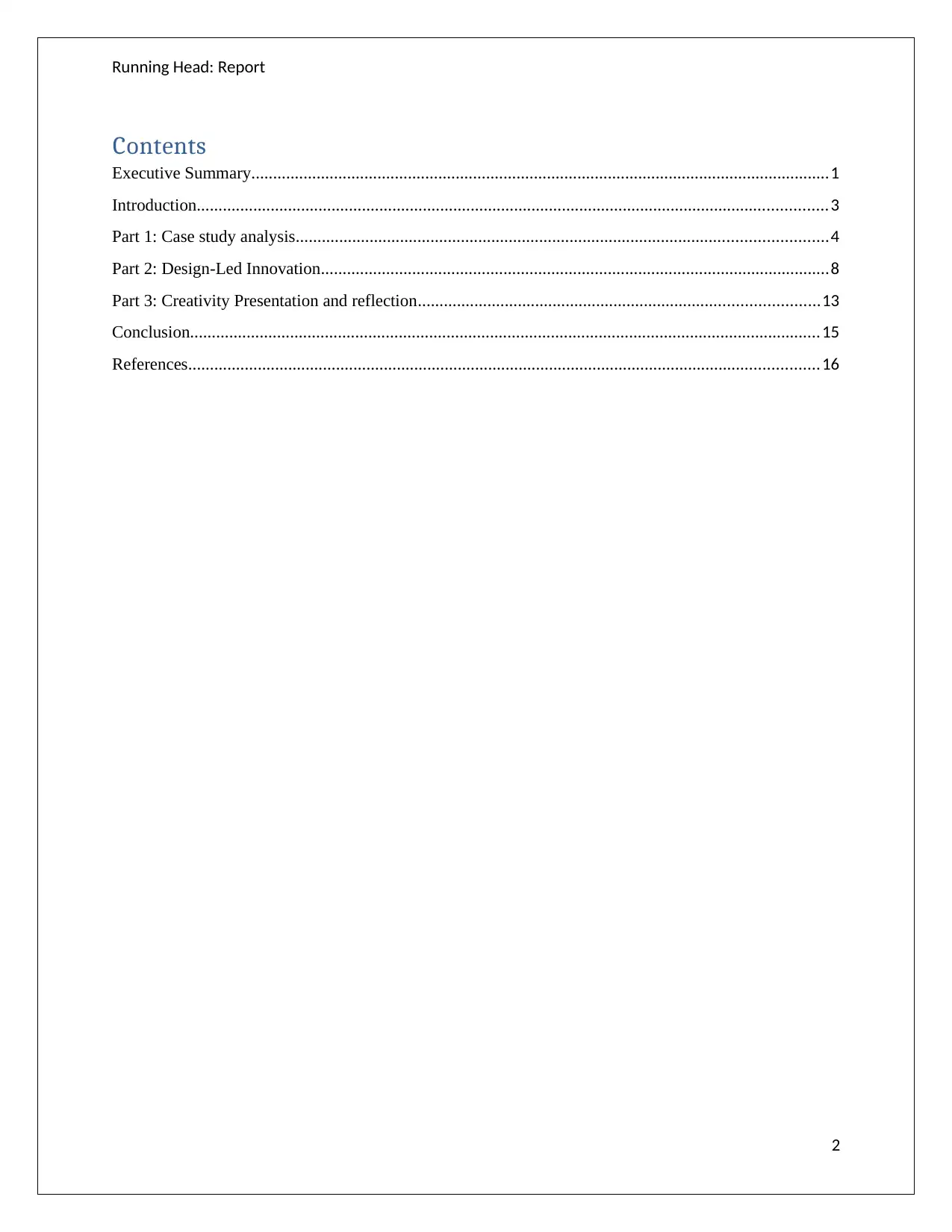
Running Head: Report
Contents
Executive Summary.....................................................................................................................................1
Introduction.................................................................................................................................................3
Part 1: Case study analysis..........................................................................................................................4
Part 2: Design-Led Innovation.....................................................................................................................8
Part 3: Creativity Presentation and reflection............................................................................................13
Conclusion.................................................................................................................................................15
References.................................................................................................................................................16
2
Contents
Executive Summary.....................................................................................................................................1
Introduction.................................................................................................................................................3
Part 1: Case study analysis..........................................................................................................................4
Part 2: Design-Led Innovation.....................................................................................................................8
Part 3: Creativity Presentation and reflection............................................................................................13
Conclusion.................................................................................................................................................15
References.................................................................................................................................................16
2
⊘ This is a preview!⊘
Do you want full access?
Subscribe today to unlock all pages.

Trusted by 1+ million students worldwide
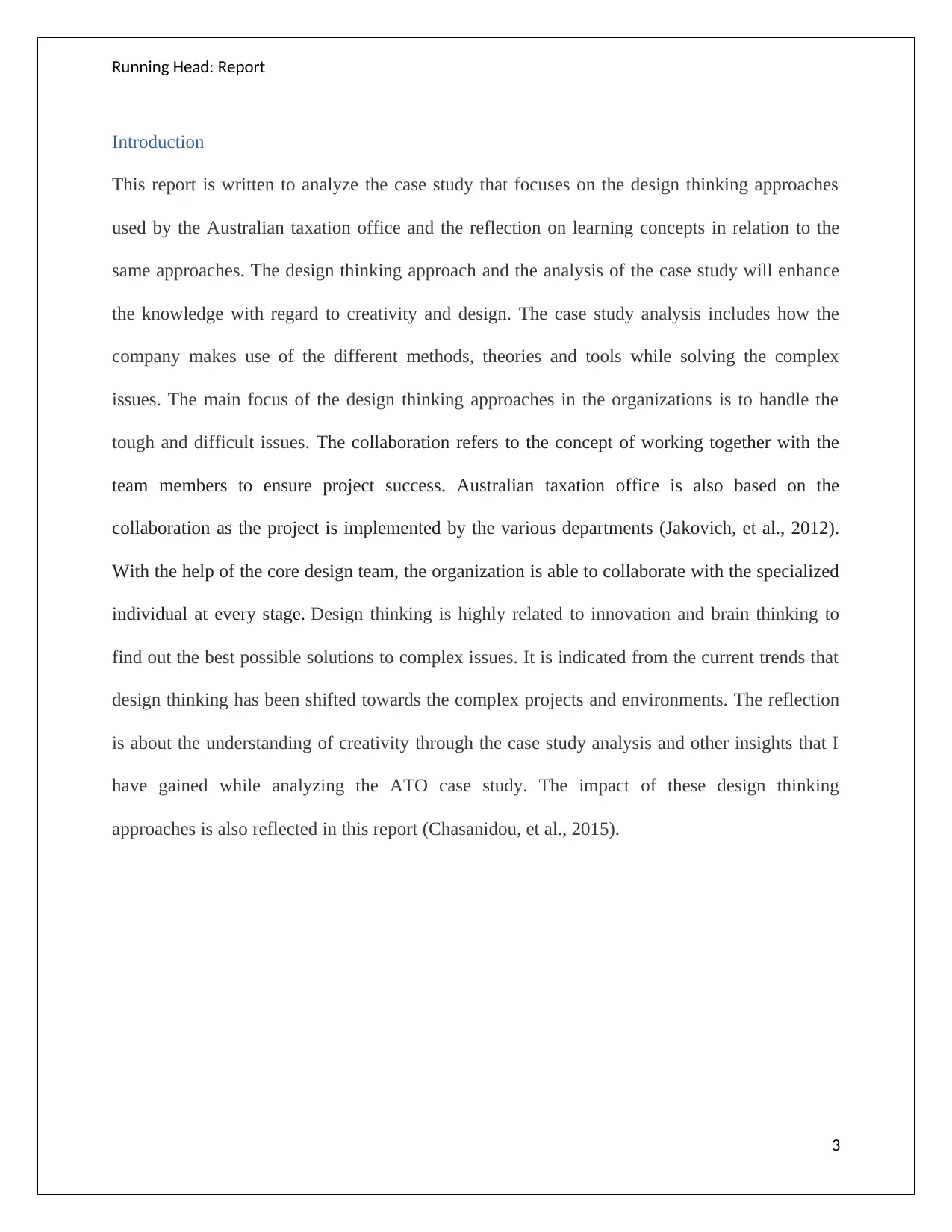
Running Head: Report
Introduction
This report is written to analyze the case study that focuses on the design thinking approaches
used by the Australian taxation office and the reflection on learning concepts in relation to the
same approaches. The design thinking approach and the analysis of the case study will enhance
the knowledge with regard to creativity and design. The case study analysis includes how the
company makes use of the different methods, theories and tools while solving the complex
issues. The main focus of the design thinking approaches in the organizations is to handle the
tough and difficult issues. The collaboration refers to the concept of working together with the
team members to ensure project success. Australian taxation office is also based on the
collaboration as the project is implemented by the various departments (Jakovich, et al., 2012).
With the help of the core design team, the organization is able to collaborate with the specialized
individual at every stage. Design thinking is highly related to innovation and brain thinking to
find out the best possible solutions to complex issues. It is indicated from the current trends that
design thinking has been shifted towards the complex projects and environments. The reflection
is about the understanding of creativity through the case study analysis and other insights that I
have gained while analyzing the ATO case study. The impact of these design thinking
approaches is also reflected in this report (Chasanidou, et al., 2015).
3
Introduction
This report is written to analyze the case study that focuses on the design thinking approaches
used by the Australian taxation office and the reflection on learning concepts in relation to the
same approaches. The design thinking approach and the analysis of the case study will enhance
the knowledge with regard to creativity and design. The case study analysis includes how the
company makes use of the different methods, theories and tools while solving the complex
issues. The main focus of the design thinking approaches in the organizations is to handle the
tough and difficult issues. The collaboration refers to the concept of working together with the
team members to ensure project success. Australian taxation office is also based on the
collaboration as the project is implemented by the various departments (Jakovich, et al., 2012).
With the help of the core design team, the organization is able to collaborate with the specialized
individual at every stage. Design thinking is highly related to innovation and brain thinking to
find out the best possible solutions to complex issues. It is indicated from the current trends that
design thinking has been shifted towards the complex projects and environments. The reflection
is about the understanding of creativity through the case study analysis and other insights that I
have gained while analyzing the ATO case study. The impact of these design thinking
approaches is also reflected in this report (Chasanidou, et al., 2015).
3
Paraphrase This Document
Need a fresh take? Get an instant paraphrase of this document with our AI Paraphraser
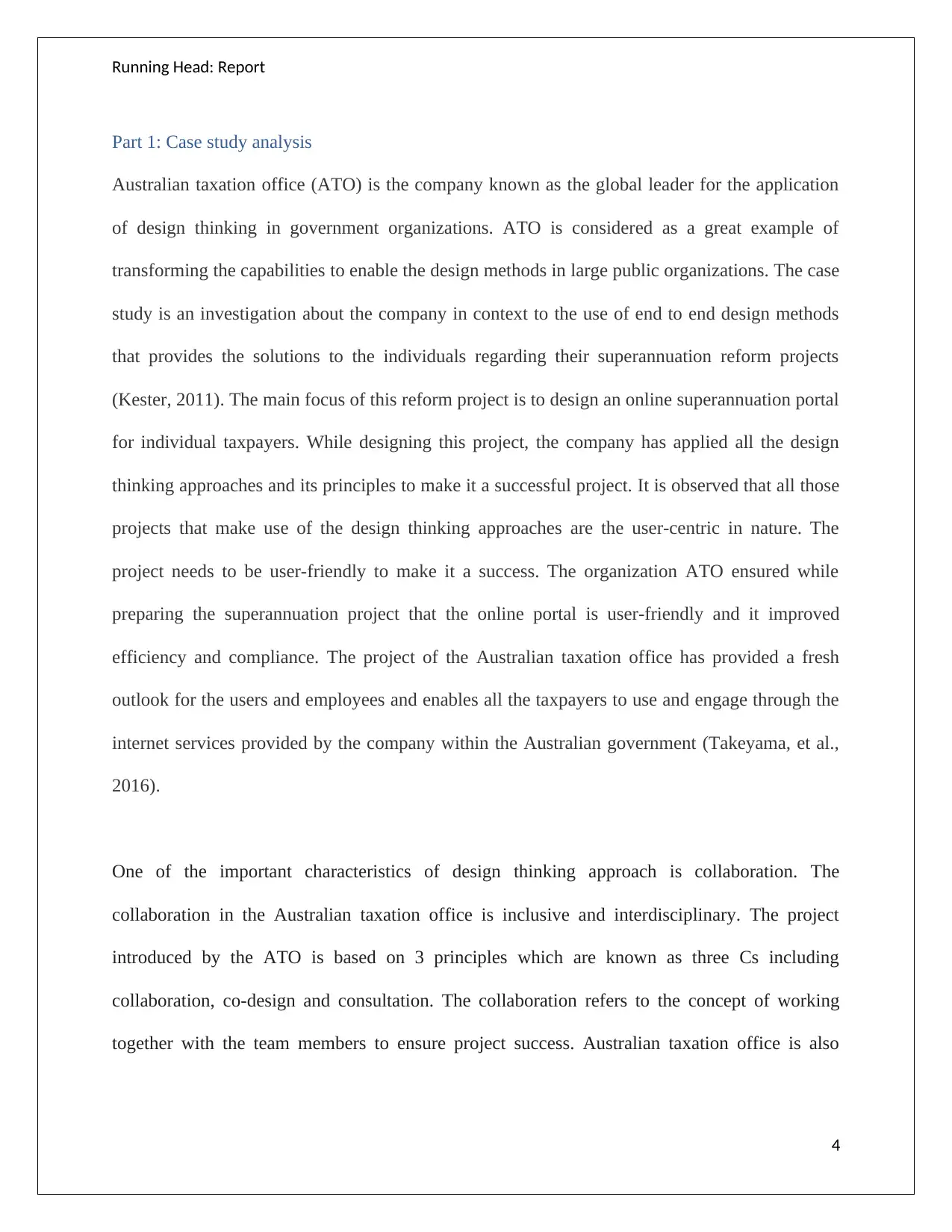
Running Head: Report
Part 1: Case study analysis
Australian taxation office (ATO) is the company known as the global leader for the application
of design thinking in government organizations. ATO is considered as a great example of
transforming the capabilities to enable the design methods in large public organizations. The case
study is an investigation about the company in context to the use of end to end design methods
that provides the solutions to the individuals regarding their superannuation reform projects
(Kester, 2011). The main focus of this reform project is to design an online superannuation portal
for individual taxpayers. While designing this project, the company has applied all the design
thinking approaches and its principles to make it a successful project. It is observed that all those
projects that make use of the design thinking approaches are the user-centric in nature. The
project needs to be user-friendly to make it a success. The organization ATO ensured while
preparing the superannuation project that the online portal is user-friendly and it improved
efficiency and compliance. The project of the Australian taxation office has provided a fresh
outlook for the users and employees and enables all the taxpayers to use and engage through the
internet services provided by the company within the Australian government (Takeyama, et al.,
2016).
One of the important characteristics of design thinking approach is collaboration. The
collaboration in the Australian taxation office is inclusive and interdisciplinary. The project
introduced by the ATO is based on 3 principles which are known as three Cs including
collaboration, co-design and consultation. The collaboration refers to the concept of working
together with the team members to ensure project success. Australian taxation office is also
4
Part 1: Case study analysis
Australian taxation office (ATO) is the company known as the global leader for the application
of design thinking in government organizations. ATO is considered as a great example of
transforming the capabilities to enable the design methods in large public organizations. The case
study is an investigation about the company in context to the use of end to end design methods
that provides the solutions to the individuals regarding their superannuation reform projects
(Kester, 2011). The main focus of this reform project is to design an online superannuation portal
for individual taxpayers. While designing this project, the company has applied all the design
thinking approaches and its principles to make it a successful project. It is observed that all those
projects that make use of the design thinking approaches are the user-centric in nature. The
project needs to be user-friendly to make it a success. The organization ATO ensured while
preparing the superannuation project that the online portal is user-friendly and it improved
efficiency and compliance. The project of the Australian taxation office has provided a fresh
outlook for the users and employees and enables all the taxpayers to use and engage through the
internet services provided by the company within the Australian government (Takeyama, et al.,
2016).
One of the important characteristics of design thinking approach is collaboration. The
collaboration in the Australian taxation office is inclusive and interdisciplinary. The project
introduced by the ATO is based on 3 principles which are known as three Cs including
collaboration, co-design and consultation. The collaboration refers to the concept of working
together with the team members to ensure project success. Australian taxation office is also
4
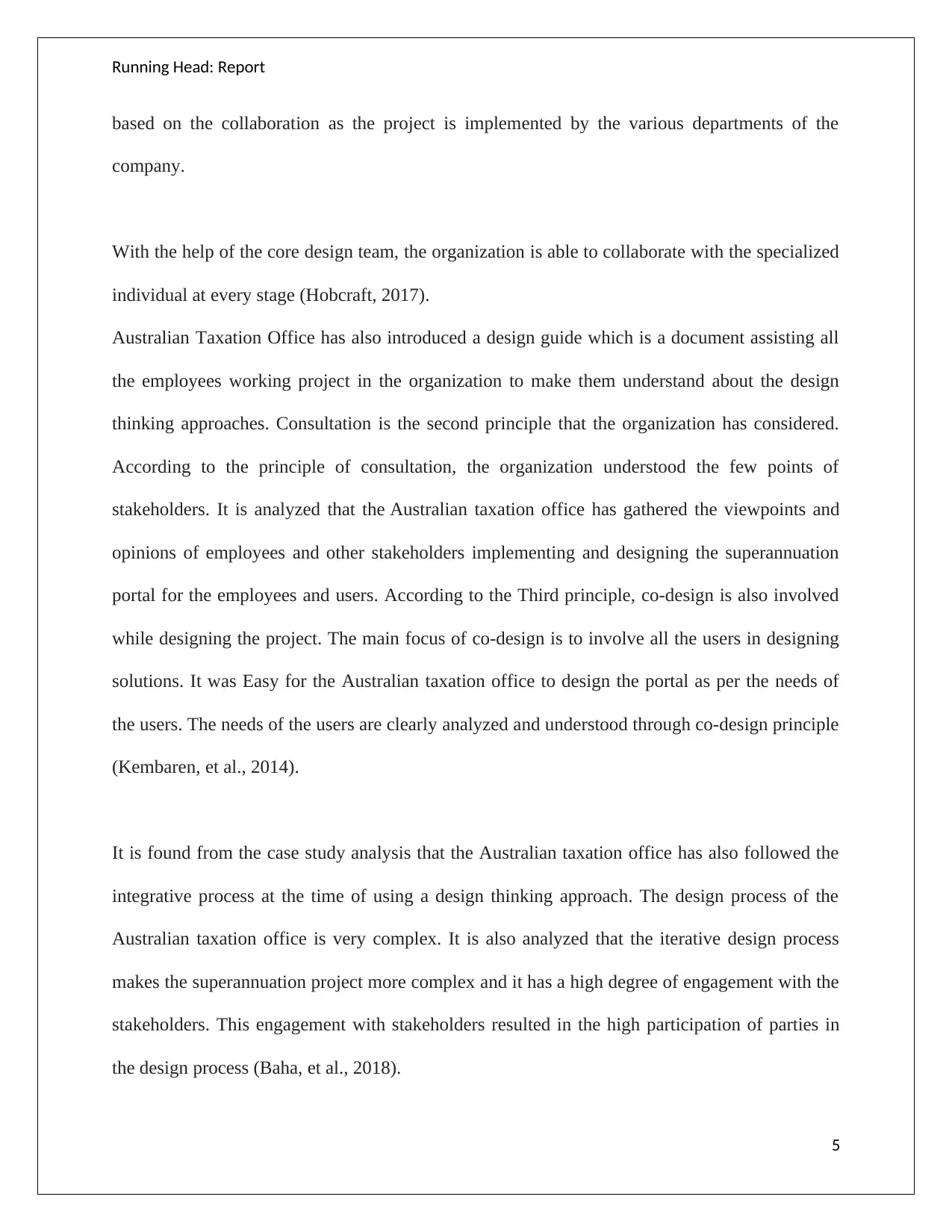
Running Head: Report
based on the collaboration as the project is implemented by the various departments of the
company.
With the help of the core design team, the organization is able to collaborate with the specialized
individual at every stage (Hobcraft, 2017).
Australian Taxation Office has also introduced a design guide which is a document assisting all
the employees working project in the organization to make them understand about the design
thinking approaches. Consultation is the second principle that the organization has considered.
According to the principle of consultation, the organization understood the few points of
stakeholders. It is analyzed that the Australian taxation office has gathered the viewpoints and
opinions of employees and other stakeholders implementing and designing the superannuation
portal for the employees and users. According to the Third principle, co-design is also involved
while designing the project. The main focus of co-design is to involve all the users in designing
solutions. It was Easy for the Australian taxation office to design the portal as per the needs of
the users. The needs of the users are clearly analyzed and understood through co-design principle
(Kembaren, et al., 2014).
It is found from the case study analysis that the Australian taxation office has also followed the
integrative process at the time of using a design thinking approach. The design process of the
Australian taxation office is very complex. It is also analyzed that the iterative design process
makes the superannuation project more complex and it has a high degree of engagement with the
stakeholders. This engagement with stakeholders resulted in the high participation of parties in
the design process (Baha, et al., 2018).
5
based on the collaboration as the project is implemented by the various departments of the
company.
With the help of the core design team, the organization is able to collaborate with the specialized
individual at every stage (Hobcraft, 2017).
Australian Taxation Office has also introduced a design guide which is a document assisting all
the employees working project in the organization to make them understand about the design
thinking approaches. Consultation is the second principle that the organization has considered.
According to the principle of consultation, the organization understood the few points of
stakeholders. It is analyzed that the Australian taxation office has gathered the viewpoints and
opinions of employees and other stakeholders implementing and designing the superannuation
portal for the employees and users. According to the Third principle, co-design is also involved
while designing the project. The main focus of co-design is to involve all the users in designing
solutions. It was Easy for the Australian taxation office to design the portal as per the needs of
the users. The needs of the users are clearly analyzed and understood through co-design principle
(Kembaren, et al., 2014).
It is found from the case study analysis that the Australian taxation office has also followed the
integrative process at the time of using a design thinking approach. The design process of the
Australian taxation office is very complex. It is also analyzed that the iterative design process
makes the superannuation project more complex and it has a high degree of engagement with the
stakeholders. This engagement with stakeholders resulted in the high participation of parties in
the design process (Baha, et al., 2018).
5
⊘ This is a preview!⊘
Do you want full access?
Subscribe today to unlock all pages.

Trusted by 1+ million students worldwide
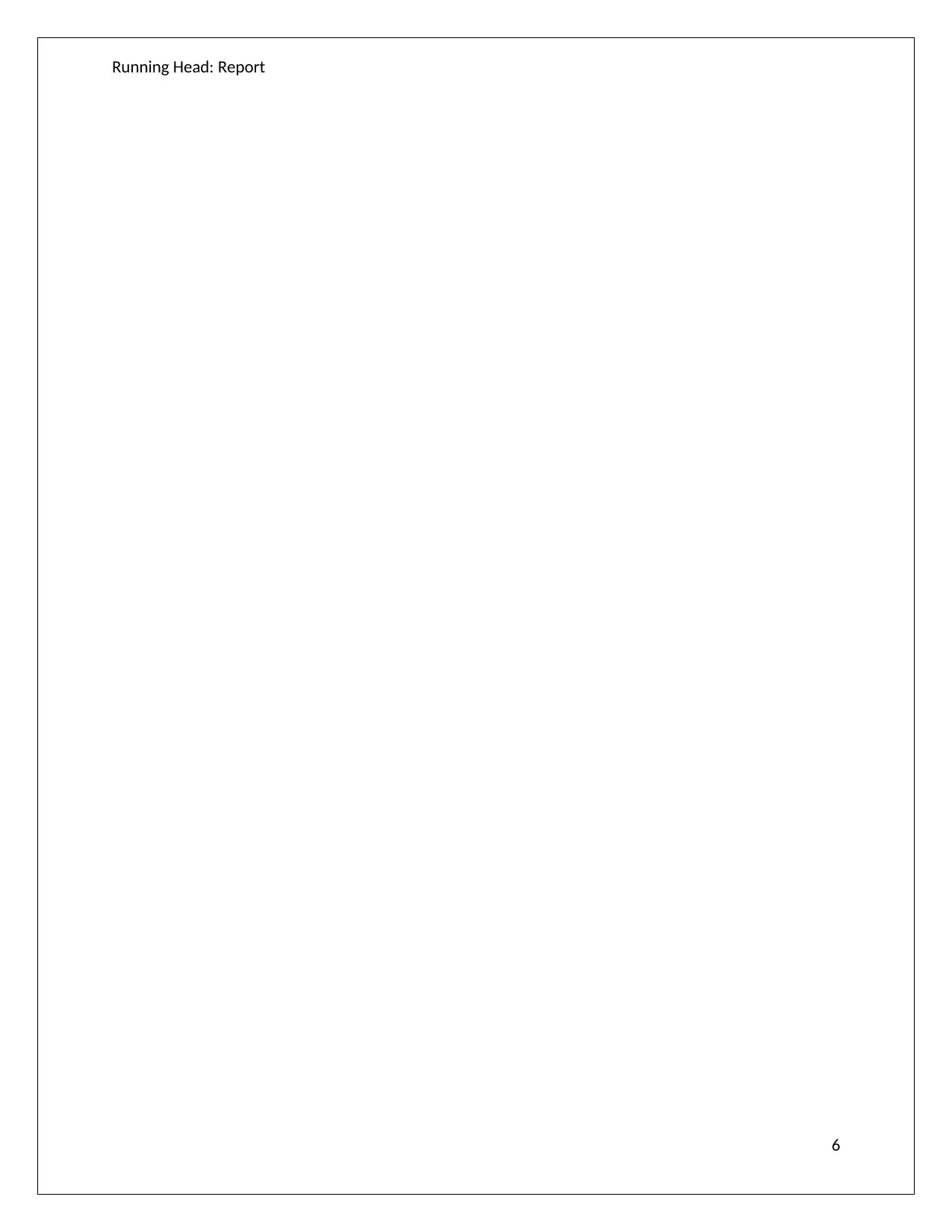
Running Head: Report
6
6
Paraphrase This Document
Need a fresh take? Get an instant paraphrase of this document with our AI Paraphraser
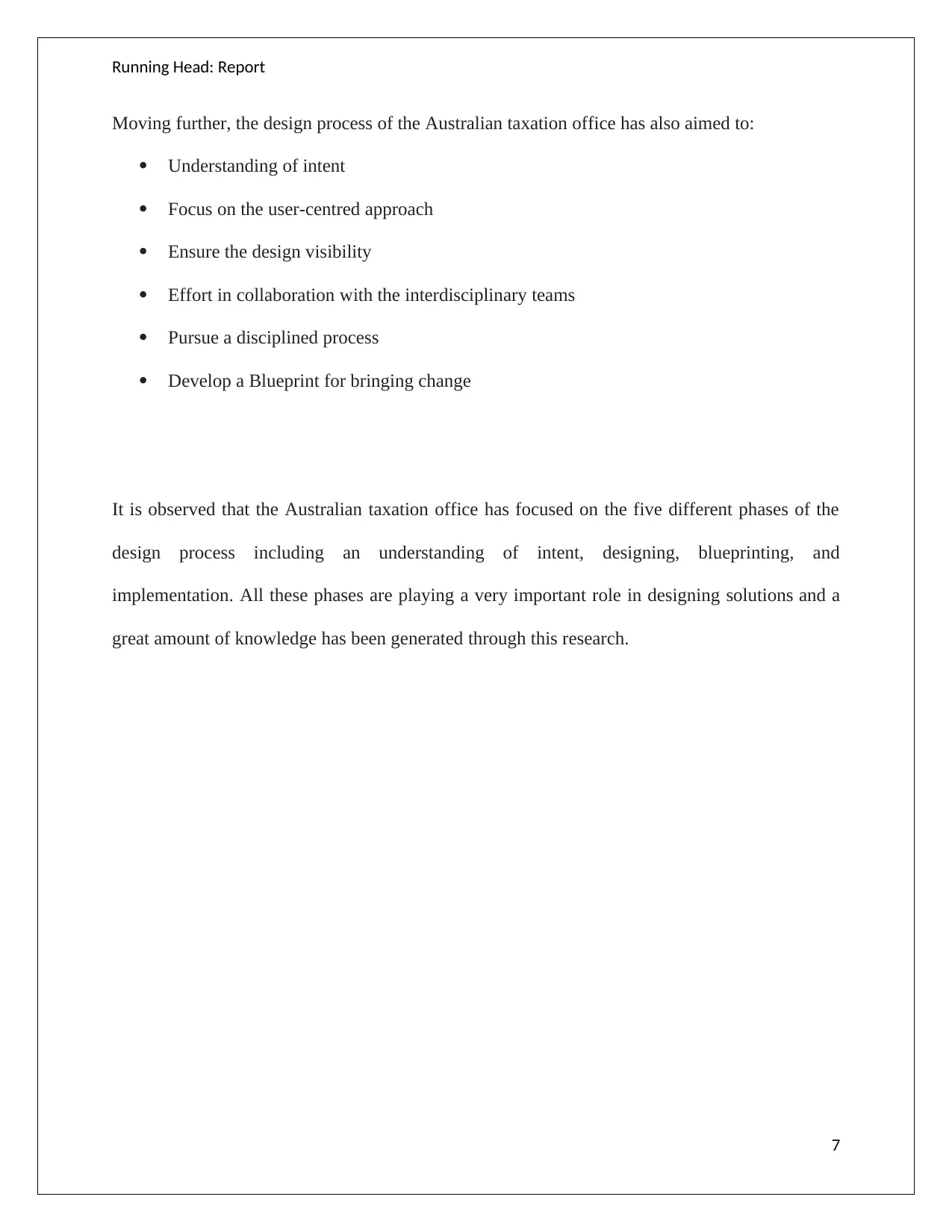
Running Head: Report
Moving further, the design process of the Australian taxation office has also aimed to:
Understanding of intent
Focus on the user-centred approach
Ensure the design visibility
Effort in collaboration with the interdisciplinary teams
Pursue a disciplined process
Develop a Blueprint for bringing change
It is observed that the Australian taxation office has focused on the five different phases of the
design process including an understanding of intent, designing, blueprinting, and
implementation. All these phases are playing a very important role in designing solutions and a
great amount of knowledge has been generated through this research.
7
Moving further, the design process of the Australian taxation office has also aimed to:
Understanding of intent
Focus on the user-centred approach
Ensure the design visibility
Effort in collaboration with the interdisciplinary teams
Pursue a disciplined process
Develop a Blueprint for bringing change
It is observed that the Australian taxation office has focused on the five different phases of the
design process including an understanding of intent, designing, blueprinting, and
implementation. All these phases are playing a very important role in designing solutions and a
great amount of knowledge has been generated through this research.
7
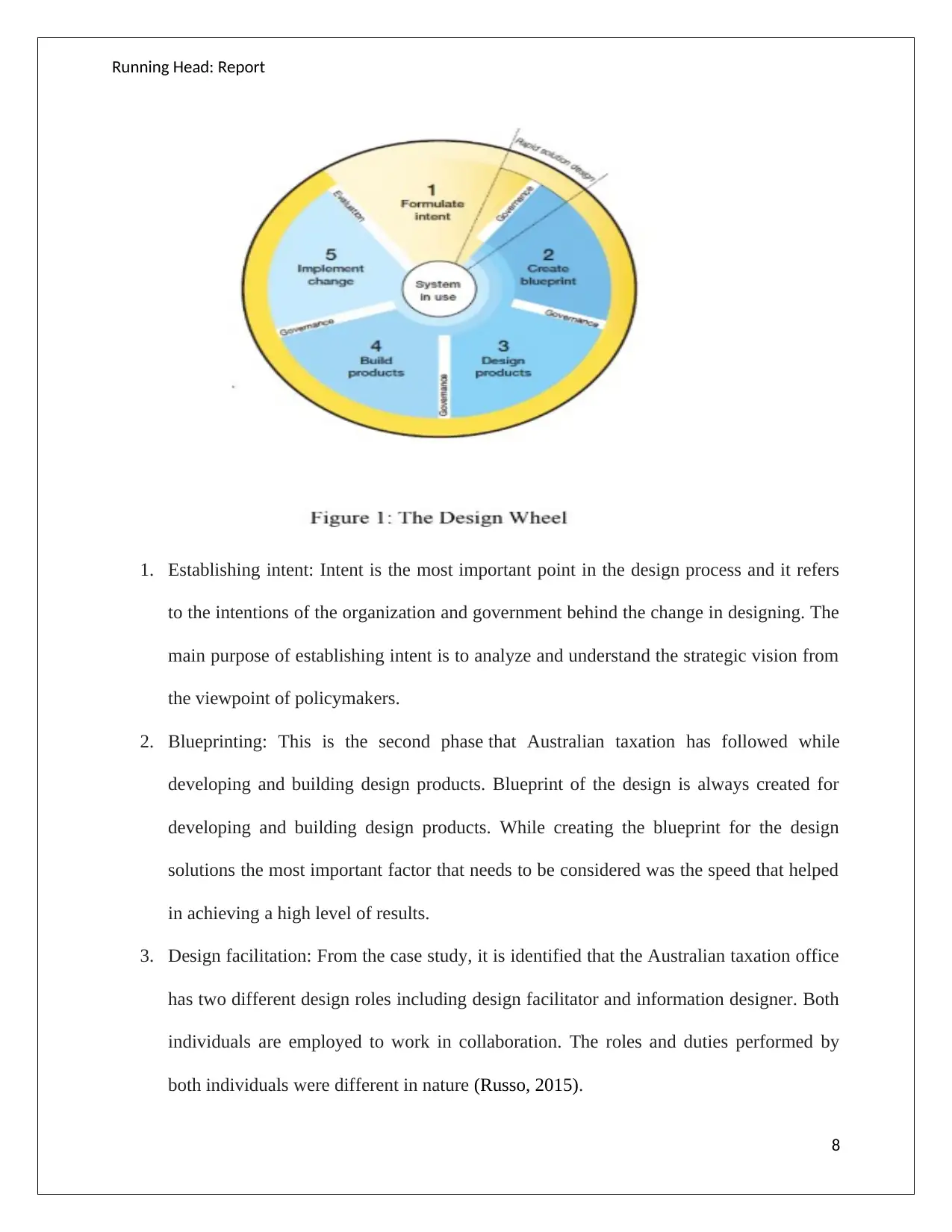
Running Head: Report
1. Establishing intent: Intent is the most important point in the design process and it refers
to the intentions of the organization and government behind the change in designing. The
main purpose of establishing intent is to analyze and understand the strategic vision from
the viewpoint of policymakers.
2. Blueprinting: This is the second phase that Australian taxation has followed while
developing and building design products. Blueprint of the design is always created for
developing and building design products. While creating the blueprint for the design
solutions the most important factor that needs to be considered was the speed that helped
in achieving a high level of results.
3. Design facilitation: From the case study, it is identified that the Australian taxation office
has two different design roles including design facilitator and information designer. Both
individuals are employed to work in collaboration. The roles and duties performed by
both individuals were different in nature (Russo, 2015).
8
1. Establishing intent: Intent is the most important point in the design process and it refers
to the intentions of the organization and government behind the change in designing. The
main purpose of establishing intent is to analyze and understand the strategic vision from
the viewpoint of policymakers.
2. Blueprinting: This is the second phase that Australian taxation has followed while
developing and building design products. Blueprint of the design is always created for
developing and building design products. While creating the blueprint for the design
solutions the most important factor that needs to be considered was the speed that helped
in achieving a high level of results.
3. Design facilitation: From the case study, it is identified that the Australian taxation office
has two different design roles including design facilitator and information designer. Both
individuals are employed to work in collaboration. The roles and duties performed by
both individuals were different in nature (Russo, 2015).
8
⊘ This is a preview!⊘
Do you want full access?
Subscribe today to unlock all pages.

Trusted by 1+ million students worldwide
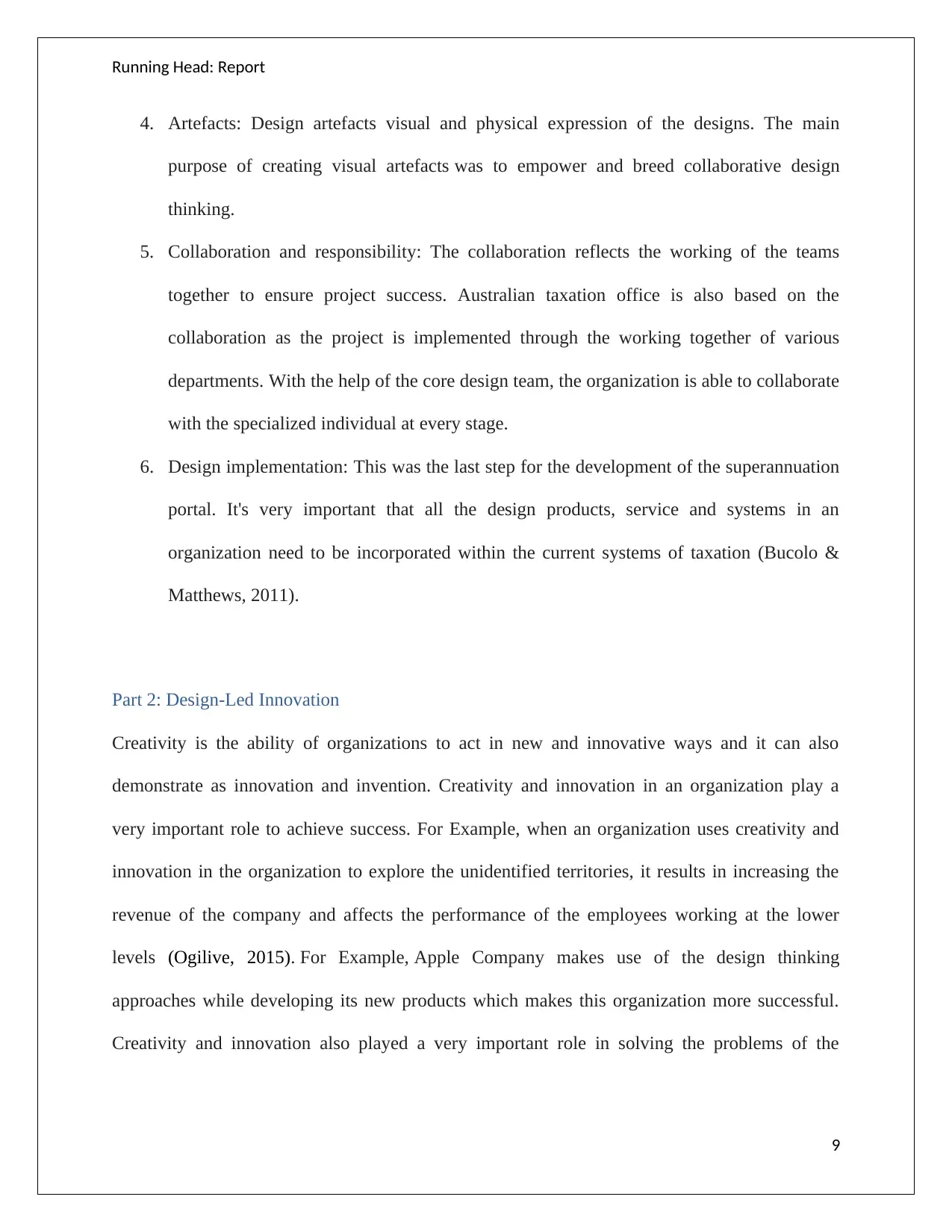
Running Head: Report
4. Artefacts: Design artefacts visual and physical expression of the designs. The main
purpose of creating visual artefacts was to empower and breed collaborative design
thinking.
5. Collaboration and responsibility: The collaboration reflects the working of the teams
together to ensure project success. Australian taxation office is also based on the
collaboration as the project is implemented through the working together of various
departments. With the help of the core design team, the organization is able to collaborate
with the specialized individual at every stage.
6. Design implementation: This was the last step for the development of the superannuation
portal. It's very important that all the design products, service and systems in an
organization need to be incorporated within the current systems of taxation (Bucolo &
Matthews, 2011).
Part 2: Design-Led Innovation
Creativity is the ability of organizations to act in new and innovative ways and it can also
demonstrate as innovation and invention. Creativity and innovation in an organization play a
very important role to achieve success. For Example, when an organization uses creativity and
innovation in the organization to explore the unidentified territories, it results in increasing the
revenue of the company and affects the performance of the employees working at the lower
levels (Ogilive, 2015). For Example, Apple Company makes use of the design thinking
approaches while developing its new products which makes this organization more successful.
Creativity and innovation also played a very important role in solving the problems of the
9
4. Artefacts: Design artefacts visual and physical expression of the designs. The main
purpose of creating visual artefacts was to empower and breed collaborative design
thinking.
5. Collaboration and responsibility: The collaboration reflects the working of the teams
together to ensure project success. Australian taxation office is also based on the
collaboration as the project is implemented through the working together of various
departments. With the help of the core design team, the organization is able to collaborate
with the specialized individual at every stage.
6. Design implementation: This was the last step for the development of the superannuation
portal. It's very important that all the design products, service and systems in an
organization need to be incorporated within the current systems of taxation (Bucolo &
Matthews, 2011).
Part 2: Design-Led Innovation
Creativity is the ability of organizations to act in new and innovative ways and it can also
demonstrate as innovation and invention. Creativity and innovation in an organization play a
very important role to achieve success. For Example, when an organization uses creativity and
innovation in the organization to explore the unidentified territories, it results in increasing the
revenue of the company and affects the performance of the employees working at the lower
levels (Ogilive, 2015). For Example, Apple Company makes use of the design thinking
approaches while developing its new products which makes this organization more successful.
Creativity and innovation also played a very important role in solving the problems of the
9
Paraphrase This Document
Need a fresh take? Get an instant paraphrase of this document with our AI Paraphraser
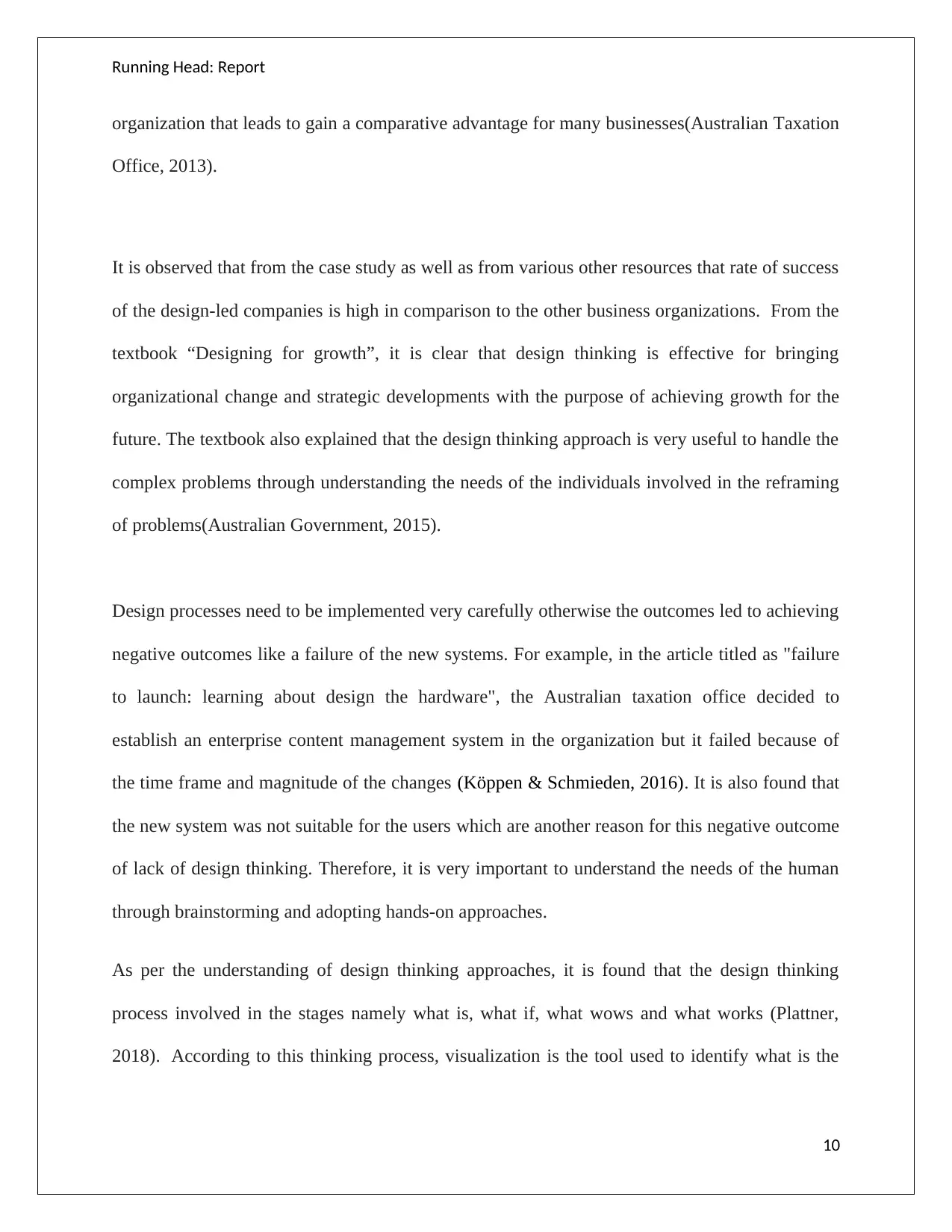
Running Head: Report
organization that leads to gain a comparative advantage for many businesses(Australian Taxation
Office, 2013).
It is observed that from the case study as well as from various other resources that rate of success
of the design-led companies is high in comparison to the other business organizations. From the
textbook “Designing for growth”, it is clear that design thinking is effective for bringing
organizational change and strategic developments with the purpose of achieving growth for the
future. The textbook also explained that the design thinking approach is very useful to handle the
complex problems through understanding the needs of the individuals involved in the reframing
of problems(Australian Government, 2015).
Design processes need to be implemented very carefully otherwise the outcomes led to achieving
negative outcomes like a failure of the new systems. For example, in the article titled as "failure
to launch: learning about design the hardware", the Australian taxation office decided to
establish an enterprise content management system in the organization but it failed because of
the time frame and magnitude of the changes (Köppen & Schmieden, 2016). It is also found that
the new system was not suitable for the users which are another reason for this negative outcome
of lack of design thinking. Therefore, it is very important to understand the needs of the human
through brainstorming and adopting hands-on approaches.
As per the understanding of design thinking approaches, it is found that the design thinking
process involved in the stages namely what is, what if, what wows and what works (Plattner,
2018). According to this thinking process, visualization is the tool used to identify what is the
10
organization that leads to gain a comparative advantage for many businesses(Australian Taxation
Office, 2013).
It is observed that from the case study as well as from various other resources that rate of success
of the design-led companies is high in comparison to the other business organizations. From the
textbook “Designing for growth”, it is clear that design thinking is effective for bringing
organizational change and strategic developments with the purpose of achieving growth for the
future. The textbook also explained that the design thinking approach is very useful to handle the
complex problems through understanding the needs of the individuals involved in the reframing
of problems(Australian Government, 2015).
Design processes need to be implemented very carefully otherwise the outcomes led to achieving
negative outcomes like a failure of the new systems. For example, in the article titled as "failure
to launch: learning about design the hardware", the Australian taxation office decided to
establish an enterprise content management system in the organization but it failed because of
the time frame and magnitude of the changes (Köppen & Schmieden, 2016). It is also found that
the new system was not suitable for the users which are another reason for this negative outcome
of lack of design thinking. Therefore, it is very important to understand the needs of the human
through brainstorming and adopting hands-on approaches.
As per the understanding of design thinking approaches, it is found that the design thinking
process involved in the stages namely what is, what if, what wows and what works (Plattner,
2018). According to this thinking process, visualization is the tool used to identify what is the
10
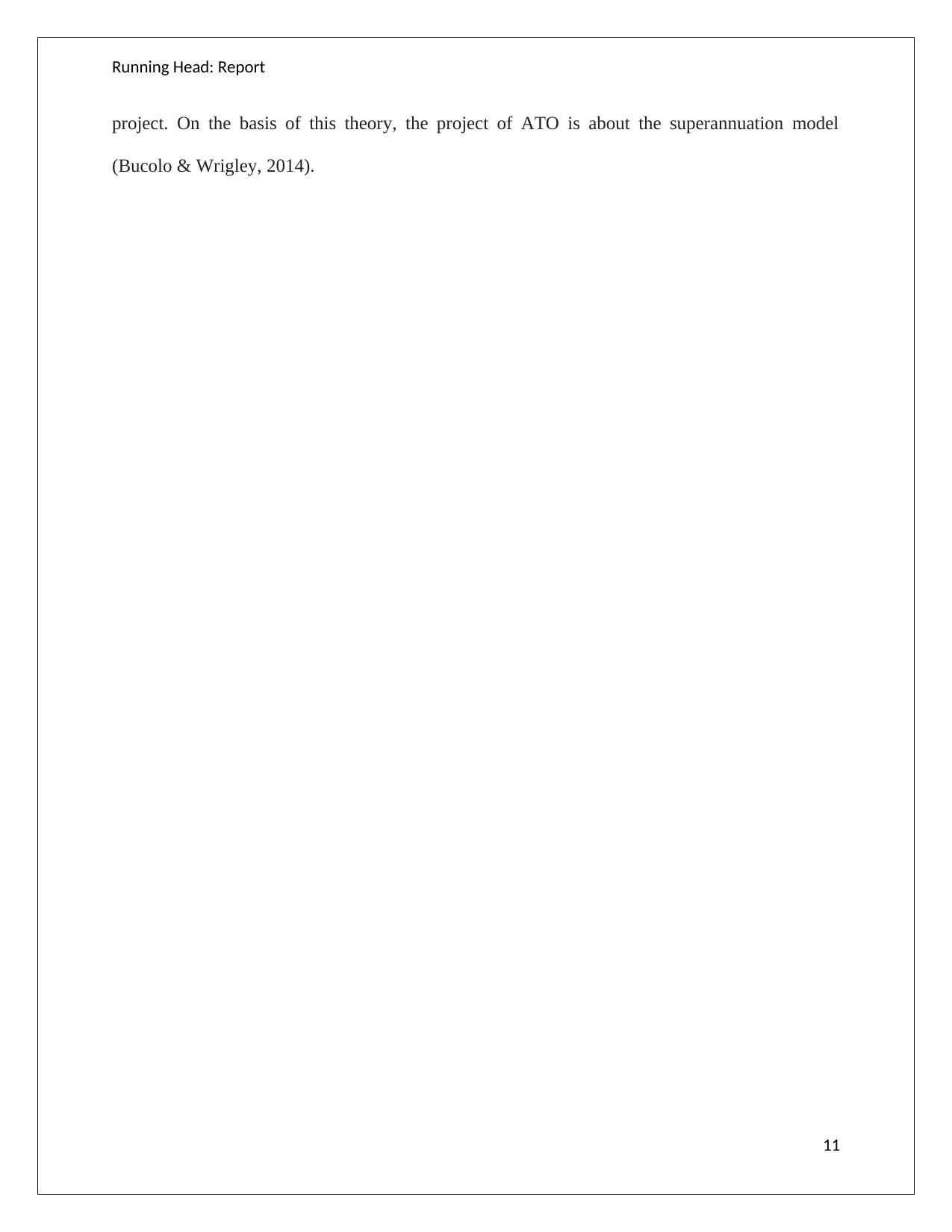
Running Head: Report
project. On the basis of this theory, the project of ATO is about the superannuation model
(Bucolo & Wrigley, 2014).
11
project. On the basis of this theory, the project of ATO is about the superannuation model
(Bucolo & Wrigley, 2014).
11
⊘ This is a preview!⊘
Do you want full access?
Subscribe today to unlock all pages.

Trusted by 1+ million students worldwide
1 out of 20
Related Documents
Your All-in-One AI-Powered Toolkit for Academic Success.
+13062052269
info@desklib.com
Available 24*7 on WhatsApp / Email
![[object Object]](/_next/static/media/star-bottom.7253800d.svg)
Unlock your academic potential
Copyright © 2020–2025 A2Z Services. All Rights Reserved. Developed and managed by ZUCOL.





